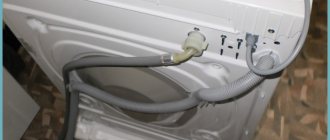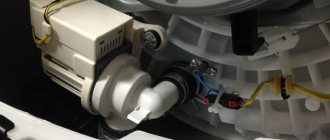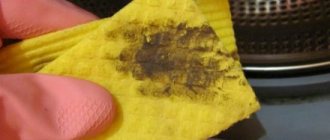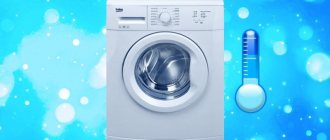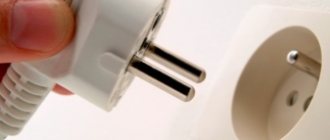Modern technologies have reduced the washing process to loading the washing machine with dirty clothes and hanging out the washed clothes. You can understand why the washing machine stops during washing by looking at the fault code on the display or by determining at what point the stop occurred. How to get things without causing a flood? How to resume washing? These questions can be answered by finding out the reason for the stop.
Important! Following the manufacturer's recommendations will help avoid breakdowns and extend the life of the washing machine.
The washing machine stops during washing: reasons
First, let's look at non-specific reasons that are not breakdowns, but indicate that you are not handling the household appliance correctly.
Reasons for stopping:
- There is a lot of clothing in the drum ; the weight exceeds that specified in the technical specifications of the machine. There is a sensor that reacts to the amount of drum loading. Therefore, if the maximum permissible weight is exceeded, the machine generates an error and stops.
- No water supply. In the summer, some regions experience low water pressure, so the amount of liquid for the washing machine may not be enough. Accordingly, it will simply turn off. You need to wait a little, and after the water supply is restored, update the wash.
- Uneven distribution of clothes in the drum. This often happens when you wash a duvet cover, down jacket or blanket. The filler clumps together. Thus, strong vibration occurs during rotation of the drum. To avoid damage, the machine turns off.
- The washing machine may stop due to the wrong program selection. There are programs that do not involve draining water and spinning. Therefore, before installation, pay attention to whether you have chosen the correct washing mode.
The machine stopped while washing
Simple solutions to emerging problems
During washing, household appliances sometimes stop performing subsequent actions or, in simple terms, may freeze. You cannot eliminate complex reasons for refusal, but there are also simple, sometimes ridiculously offensive ones. Here are the most common causes of simple washing machine failures.
The weight of the laundry exceeds the norm
Some models have a built-in smart sensor that is responsible for exceeding permissible limits. What to do in this case is very clear - remove excess laundry and start the machine again. If everything is normal, then you have correctly identified the cause.
Incorrect task
Sometimes users set a delicate wash, and then panic that the machine has stopped and won’t spin. There is no such function in this mode, and automation has nothing to do with it. Turn on forced drain and then spin mode.
An imbalance has occurred
When washing small and large items, an emergency situation may occur when the laundry collects in a single lump in one part of the drum. The imbalance sensor is triggered and a stop occurs. Not all users immediately understand the reason for the equipment failure, however, when opening the loading hatch, everything becomes clear: you need to evenly distribute the laundry items inside the drum and start the spin mode from the beginning.
Special sensors are installed by the manufacturer to prevent emergency situations: the appearance of unacceptable vibration due to imbalance, a large load on the electric motor when the laundry is overweight. These measures protect household appliances from overload.
Program selection error
Users sometimes make basic mistakes by choosing several washing modes at once. As a result, the washing machine stops without finishing washing. For example, the housewife chose the “Soak”, “Wash” and “Bleaching” program. Smart technology will stop in the middle of the process, because it does not have a combined “Whitening” and “Soaking” mode: they must be launched separately.
Manufacturers of modern automatic devices always very clearly describe all programs and modes, and they do not forget about the features. You should carefully study the attached instructions to avoid annoying mistakes. Household appliances wash in stages and strictly according to the programmed program, so carefully select the desired mode.
Why does the washing machine stop during washing: reasons requiring professional intervention
Very often, stopping the machine is associated with some serious breakdowns, which only a specialist can fix.
Reasons for stopping:
- If the machine freezes at the very beginning of the wash, then most likely the problem is in the water supply or in the heater itself. Household appliances cannot heat water. Accordingly, the operating modes are disrupted. In this case, the program may freeze or an alert may be issued.
- A stop in the middle of the cycle is most often observed if the drain does not work. That is, the problem may be in the pump, pump or filter. In this case, the machine also gives a corresponding signal. Thanks to the number of flashes, a breakdown can be determined.
- Stopping the machine at the very end of the wash may also indicate that the heating element has stopped working or there is a problem with draining the water. The filter may be clogged. Such problems cannot be solved on your own; you will have to contact a service center for help.
The machine stopped while washing
Typical faults
- The washer stopped in the last minute of washing or stopped draining. The reason is a breakdown of the heating element or pump. A sign of a malfunction of the heater is also freezing at the beginning of the wash, possibly at the same time.
- If the electronic module malfunctions, the appliance freezes during the first wash cycle or immediately after turning it on. These signs also indicate a malfunction of the UBL hatch lock. If the machine does not complete the wash, this also indicates problems with the electronics.
- Problems in the drainage system (hoses, pump) are indicated by hanging on the same program - rinsing or spinning. There may be a blockage in the hoses, or the pump is faulty and the water is not draining.
- If the washer spins the drum 2 times and freezes, or you hear a crackling and humming sound, the problem is in the motor. The motor could burn out due to water ingress or overvoltage. Or its brushes are worn out.
If there is a malfunction, the timer or program selector may spin constantly.
What to do if the washing machine stops during washing?
You need to look at the number of blinks and try to determine what is actually broken in the car. If you cannot detect a breakdown or the machine is simply frozen, you need to turn off the power and wait until the door opens. Under no circumstances should the door be opened if it is firmly closed. You will only break it. In addition, it is unwise to open the door if there is water inside the drum. Everything will just spill out.
Instructions:
- To do this, you need to use the emergency water drain.
- At the bottom of the washing machine on the right side, there is usually a window with a drain filter, which must be cleaned once a month to remove coins, hair and other debris.
- This filter has a small hose, you need to take a bowl, open this hose and drain all the water
- This is a lengthy procedure, because the diameter of the hose is small and there is a lot of water in the drum.
- Only after you have done this will you need to open the door, remove the items, transfer them to a bowl, rinse them, and hang them out to dry
- You must try to turn on the machine again. You don't have to throw things there at all. After turning off, draining the water, try turning on again
- If the situation repeats, the machine constantly produces some kind of error, indicating this by flashing lights or sound signals, you must contact a service center
- Sometimes it happens that there is a failure in the power supply system. The machine just freezes, and when you turn it on again, the program starts, the machine works as usual
The machine stopped while washing
Often the machine stops precisely because of problems with the software or the system board. These breakdowns are difficult to repair and most often require replacing the system board itself, which is quite expensive. Replacing it solves problems with the operation of the washing machine, and the functionality of the equipment is completely restored.
The machine stopped while washing
As you can see,
If the washing machine stops during washing, you need to turn it off from the power supply and try to figure out the cause of the breakdown. If this has nothing to do with the power supply or water supply, then you will have to use the services of a service center or a technician.
Focus on the heating element
The washing machine does not start washing if the heating element or the temperature sensor connected to it is broken. The explanation is simple: before starting the cycle, the system automatically checks all key components, detects heating problems and cancels the start. Sometimes the termination of the program is accompanied by an error code on the display, but more often the machine freezes “silently”.
To confirm your guess, you need to check the heating element for serviceability. The heating element on most washing machines is located at the bottom, under the washing tub. But first, we disconnect the machine from communications and move it away from the wall. Then you should unscrew the bolts holding the rear panel, move the “back” to the side and find a round “chip” with many connected wires next to the engine. This will be the heater. Having discovered the heating element, we proceed in the following order:
- we photograph the location of the connected wires, thereby simplifying the reverse connection;
- release the wiring from the terminals;
- take a multimeter, turn it on to “Ohmmeter” mode and set it to 200 Ohm;
- apply the tester probes to the contacts of the heating element;
- We evaluate the readings of the device (the norm is 26-28 Ohms).
A burnt heating element cannot be repaired - only replaced with a new one!
If instead of the required 26-28 Ohms the multimeter outputs “1”, it means that the heating element is faulty due to an internal break. The “O” that appears on the display will indicate a short circuit. In both the first and second cases, repair will not help - only replacement. The next step is to check the heating element for breakdown. We activate the buzzer mode, touch the probe to the heater and evaluate the result. Did the device beep? Then the element cannot be used, but must be urgently replaced with a new one. To replace a faulty heating element, it must be dismantled. Sometimes this is difficult to do - the rubber seal located under the heater often expands during operation, blocking the device. You can deal with the obstacle as follows:
- generously lubricate the gasket with detergent;
- wait 10-20 minutes;
- disable the temperature sensor;
- loosen the central nut, but do not remove it completely;
- press the bolt inward;
- Having rocked the heating element, remove it from the grooves.
Finding a new heating element will not be difficult. The main thing is to look for the serial number of the washing machine or heater when searching for an analogue. A win-win option is to bring the dismantled element to the store and ask for a replacement. You can install a new heater yourself. First, you should clean the seat, then fix the heating element in the grooves, return the thermistor and wiring. When connecting the latter, it is important to focus on the photographs taken before dismantling.
Before calling the specialist
First, try to carry out simple diagnostics yourself to make sure that the problem is a malfunction of the machine itself:
- First of all, you should make sure that the machine is connected to the network. If everything is in order, but it still does not turn on, make sure that there is current in the network. Voltage fluctuations can lead to a malfunction of the outlet, and the one in which the machine is plugged in. To make sure there is voltage, try connecting another electrical appliance to the same outlet.
- Check that the plug and the cord itself are in good condition and free of damage. If everything is fine with the power supply, but the washing machine still does not turn on, then you should look for a fault in the device itself. Carefully inspect the surface of the plug and cord. Make sure there is no burning on them and no unpleasant smell of burning plastic. If such damage is discovered, you should not reconnect the machine to the network. The malfunction in this case will consist of damage to the wire, and to solve the problem it is enough to replace it.
If everything is in order with the cord, plug and socket, then the fault is probably in the internal technical components of the device and this cannot be done without the help of a professional.
Calling a master: where to find and how much to pay?
If it is impossible to carry out diagnostics and repairs yourself, you must call a specialist. It is better to search for a company that repairs household appliances on the Internet.
The cost of work depends on the company’s pricing policy and the complexity of the breakdown.
Average prices are:
It should be borne in mind that the cost of work does not include the price of new parts if replacement is required. If a new part that needs to be installed instead of a worn one is already in stock, this must be reported to the dispatcher accepting the order.
Contacting random repairmen whose phone numbers were found through an ad may result in poor-quality repairs. In addition, there is a chance of falling for scammers who will carry out the work negligently. After the repair work is carried out, the company representative gives a guarantee .
A lot of important and useful information about repairing Indesit washing machines is presented in this section.
Video instruction
Your machine may stop while washing. Before finding the cause, you need to drain the water. This video clearly shows what needs to be done if the machine stops with water.
An automatic machine is not a cheap thing. Sometimes it fails or may stop during the washing process. The reason may be either a banal violation of operating rules or a breakdown of an important unit. If you find the cause, you can try to eliminate it yourself. But if you are not confident in your abilities, call a specialist.
Features of the problem for different machine manufacturers
Washing machines are presented on the domestic market in a wide variety; each model has its own weak points, which can lead to freezing in the rinse mode.
- Samsung has rather weak electrics, so the slightest changes in the network lead to the settings of the electronic module being reset, and the user’s settings are no longer perceived by the device. Because of this, the machine does not load this program and freezes.
- LG is high quality equipment. However, its components are located very awkwardly, so it is not so easy for users to remove the filter for cleaning, not to mention other elements that need to be washed periodically to prevent damage.
- Zanussi and Indesit AGRs produce strong vibrations during operation, resulting in hardware malfunctions. In addition, the rubber gaskets in them leave much to be desired, so the hatch cover may become depressurized.
- Ariston makes a lot of noise, which leads to software failures and the machine begins to wash synthetics for 1.5 hours instead of the required 29 minutes.
- Bosch in the old days produced the highest quality equipment. However, modern models often cause complaints from users, including many who note frequent freezing at rinsing and insufficient rinsing of the powder.
- Beko has rather stiff control buttons, so the user sets the mode, but the equipment does not carry it out. Due to such leaps in technology, hardware malfunctions sometimes occur.
Problem with sensors
If the machine starts washing and stops for no apparent reason, there may be a problem with the sensors. They are used to monitor processes and operating status. The main ones:
- water level sensor;
- laundry balance sensor;
- speed control sensor;
- temperature sensor.
If the sensor fails or does not work correctly, it transmits inaccurate information to the control unit. The machine cannot understand what the current water level is, what temperature, speed and other parameters are. This causes the machine to stop during rinsing or at any stage of the wash.
What happened to the technology?
Usually, if an automatic machine freezes in the middle of a cycle and does not want to work, after 5-10 minutes an error appears on its screen. By deciphering the fault code, you can narrow down the range of possible problems. Washing machines without a display indicate a breakdown by flickering LEDs on the dashboard.
When the machine simply refuses to function and does not display an error, you have to identify the problem yourself, “cutting off” possible causes. Typically, SMA freezing is caused by:
In addition to all this, if the washer fills with water and stops, there may be problems with the inlet solenoid valve. When the drain system is clogged, the machine simply will not be able to remove the liquid and start rinsing, so it will remain stuck with a full tank. Let’s figure out what to do to get the “home assistant” back on track.
